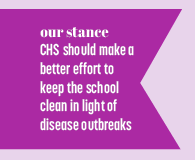
The information in this issue—originally scheduled for publication on March 20—was written and produced prior to news regarding school cancellation from the COVID-19 virus. Some information may be outdated or inaccurate as a result.
Student staff members worked hard to produce this content and, despite the circumstances, we still wanted readers to have an opportunity to see it.
Thank you for your readership.
In January, seven schools in Indiana closed for the day due to the flu, according to WFYI-TV. So far this season, the Indianapolis Star reported 31 deaths in Indiana due to the flu, nearly four times the amount in the 2018-19 season. These numbers alone are enough to urge this school to take a closer look at how it attempts to prevent the proliferation of illness. The new outbreak of COVID-19 only adds to the urgency.
A high school, particularly one like CHS, is going to be a “petri dish” regardless of precautions; this is a natural product of having 6,000 people in the same building at the same time. While the work the custodians currently do to keep the school clean is outstanding, administration can make their jobs easier by doing more on the front end. There are two specific places where they can act: the classroom and the cafeteria.
The first addition the school should implement is to ensure there are tissue boxes and hand sanitizer in all classes. Many classrooms have nothing at all, forcing students to constantly leave class to clean their nose or, even worse, wipe with their hands. By having tissue boxes in class, disruptions are minimized and an ill student can get through their day with less struggle. The addition of hand sanitizer will allow students to take more sanitary precautions without disrupting learning.
Second, the school cafeterias are among the hardest places to clean during the day and could be a hotbed for pathogens. Students rarely wash their hands before they eat due to the time crunch of lunch. To fix this, the school could place hand sanitizer on every table, as just a quick squirt allows students to kill off most of the pathogens on their hands, preventing contamination. Another solution is to have hand sanitizer bottles at the checkout line, where the cafeteria staff can make sure students clean their hands before they take their trays.
It is extremely difficult for all of the cafeteria staff to clean every table in the brief five minute interval between lunch periods. To alleviate this, Clorox wipes could be placed on every table, allowing students to complete the job themselves.
Although the cost of purchasing these materials is considerable for administration, as they would have to buy hundreds, the benefits outweigh the cost. The school can make crucial progress in the goal of creating a healthier, safer environment. To relieve these pressures, students could also bring in tissues and other items to donate.
In the end, administration must make an effort to give the power to students to keep themselves clean throughout the school. On that note, though, students have to hold up their end of the bargain once these measures are put in place. The stakes of inaction (an illness sweeping through the school, canceling school days) are very high, and administration, staff and students must immediately work together to prevent such scenarios.
Click here to learn more about preventing the spread of the new COVID-19.































![What happened to theater etiquette? [opinion]](https://hilite.org/wp-content/uploads/2025/04/Entertainment-Perspective-Cover-1200x471.jpg)














































![Review: “The Immortal Soul Salvage Yard:” A criminally underrated poetry collection [MUSE]](https://hilite.org/wp-content/uploads/2025/03/71cju6TvqmL._AC_UF10001000_QL80_.jpg)
![Review: "Dog Man" is Unapologetically Chaotic [MUSE]](https://hilite.org/wp-content/uploads/2025/03/dogman-1200x700.jpg)
![Review: "Ne Zha 2": The WeChat family reunion I didn’t know I needed [MUSE]](https://hilite.org/wp-content/uploads/2025/03/unnamed-4.png)
![Review in Print: Maripaz Villar brings a delightfully unique style to the world of WEBTOON [MUSE]](https://hilite.org/wp-content/uploads/2023/12/maripazcover-1200x960.jpg)
![Review: “The Sword of Kaigen” is a masterpiece [MUSE]](https://hilite.org/wp-content/uploads/2023/11/Screenshot-2023-11-26-201051.png)
![Review: Gateron Oil Kings, great linear switches, okay price [MUSE]](https://hilite.org/wp-content/uploads/2023/11/Screenshot-2023-11-26-200553.png)
![Review: “A Haunting in Venice” is a significant improvement from other Agatha Christie adaptations [MUSE]](https://hilite.org/wp-content/uploads/2023/11/e7ee2938a6d422669771bce6d8088521.jpg)
![Review: A Thanksgiving story from elementary school, still just as interesting [MUSE]](https://hilite.org/wp-content/uploads/2023/11/Screenshot-2023-11-26-195514-987x1200.png)
![Review: "When I Fly Towards You", cute, uplifting youth drama [MUSE]](https://hilite.org/wp-content/uploads/2023/09/When-I-Fly-Towards-You-Chinese-drama.png)
![Postcards from Muse: Hawaii Travel Diary [MUSE]](https://hilite.org/wp-content/uploads/2023/09/My-project-1-1200x1200.jpg)
![Review: "Ladybug & Cat Noir: The Movie," departure from original show [MUSE]](https://hilite.org/wp-content/uploads/2023/09/Ladybug__Cat_Noir_-_The_Movie_poster.jpg)
![Review in Print: "Hidden Love" is the cute, uplifting drama everyone needs [MUSE]](https://hilite.org/wp-content/uploads/2023/09/hiddenlovecover-e1693597208225-1030x1200.png)
![Review in Print: "Heartstopper" is the heartwarming queer romance we all need [MUSE]](https://hilite.org/wp-content/uploads/2023/08/museheartstoppercover-1200x654.png)


